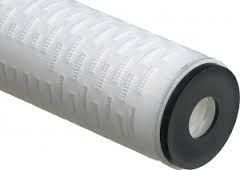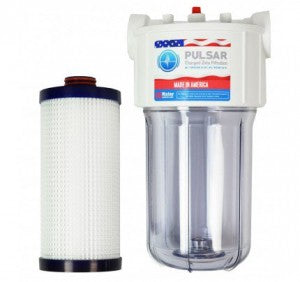Pulsar Disruptor Filter - A Game Changer
New Pulsar™ Disruptor® Filter with Ahlstrom Media

The Pulsar Disruptor Filter is a disruptive technology, in that it displaces an established technology and shakes up the industry or a ground-breaking product that creates a completely new industry. When the PC replaced the typewriter, it forever changed the way we work and communicate. Cell phones were “disruptive technology” because it allowed us to communicate from almost anywhere and the Pulsar Disruptor Filter System is “disruptive technology” in that a filter system can now reduce or remove the following contaminants:
- Bacteria
- Iron
- Virus
- Copper
- Cysts
- Lead
- Tannin
- Chromium VI
- Endotoxins
- Selenium
- Legeonella
- Tannic Acid
- Silica
- Humic Acid
- Heavy Metals
- Cryptosporidium
- Fulvic Acids
The Pulsar Disruptor filter is manufactured with Nano Alumina Fibers that have a Zeta potential of 51 millivolts. A CZF cartridge retains bacteria, virus, cryptosporidium oocysts and even tannin with its strong Zeta Potential. To removes cysts and bacteria. Unlike mechanical filters which rely on “pore size” the Charged Zeta Technology literally “secures” the contaminant. It is “absorbed” in a very real way. The filters have a long life and are easily replaceable. The Pulsar Disruptor filter media is manufactured from a naturally occurring element called boehmite, which has no known Health Side Effects. In fact, boehmite has long been used as an additive to food products and digestive analgesics. Additionally, it has passed testing for NSF/ANSI Standard 42 and 61 for potable water and USP Class VI testing and endotoxin testing. Pulsar Disruptor filter media is engineered with this 51 millivolt charge covering the entire volume and depth of the media. A Pulsar Disruptor filter accomplishes submicron filtration with a “charge” rather than “pore size” filtration, which allows for virtually zero pressure drop and high flow rates. If you compare the Pulsar Disruptor filter to “ultrafiltration” membranes, you will find dramatically higher flow rates with less pressure drop. In summary, with the Pulsar Disruptor filter, you get the following:
- High efficiency reduction
- Electroadsorptivereduction of virus
- Electroadsorptive and mechanical reduction of bacteria and endotoxin
- Mechanical removal of cysts
- Higher flow rates and lower pressure drop than membranes

DOE or SOE Filter Cartridge However, the filter choices and performance often depends upon on the seal integrity within the filter vessel. Double Open End (DOE) or Single Open End (SOE) gasket cartridges on some brands of cartridges may have very high efficiency capability but their reliance on a “knife” or pressure seal may not maintain a positive seal sufficient to stop the migration of microbial contaminants due to pressure shifting or pulsations changes from varying flow rates, which can break the seal! Without a proper seal, microbial contamination is likely to occur right from the start. Cartridges using a knife or pressure seal do not have the tolerances sufficient to act as a microbial barrier.

Pulsar Disruptor Filter with 222 Filter Seal Filter cartridges with a double O-ring seal such as a 222 or 226 (or similar design) that fit into a receiver, within the element vessel, and that provides an O-ring compression necessary to prevent by-pass are the type of filters that should be used. The Pulsar Disruptor Electro-adsorptive technology is now available at US Water Systems, and it does not rely on pore size exclusion for high levels of microbial reduction. It also does not release the retained contaminants in an event of an integrity breach. The electro-positive charge captures and retains contaminants throughout the depth of the pore structure. This method reduces microbes via adsorption + mechanical filtration not simply pore size exclusion. The electro-adsorptive charge provides a net adsorption efficiency of ~.002 um and mechanically with a mean pore size of approximately 1.2 microns. The charge field removes the negatively charged, submicron particles while larger particles are captured within the fiber structure of the media. This method reduces virus by > 4 LRV with a mechanical mean pore size of approximately 1.2 microns. Electro-adsorption provides “retention” of the organisms through these charged structures within the media and small integrity breaches, which may occur, does not produce a catastrophic release of organisms. Mechanical pore dependent membranes and filters do not enjoy this benefit. This filter media has over 400 layers of pore depth created by a wet laid non-woven manufacturing process. This results in a media having a torturous flow pattern, high flow rates at low pressure drop. The charge field results in a high initial removal efficiency as well as high loading capacity. This results in high energy saving. This media has been sold commercially for years with great results. When used with appropriate and proper pre-filtration for particulates, it provides efficient life cycles between cartridge changes. While the media performance is excellent it still requires good manufacturing practices and the integrity of the finished product is just as critical as membranes. This media requires manufacturing knowledge and experience as it can be difficult to pleat due to its 1 mm thickness and composite structure. A quality control procedure with 100% NDPT (Non Destructive Performance Test) or reverse bubble testing in alcohol solution is required at the production facility for every cartridge to insure the integrity. Spent elements and cartridges that remove microbes become a bio hazard and without an antimicrobial additive to control these microbes cannot be disposed of as normal waste. This issue is most often overlooked and the elements and cartridges are typically disposed of in the trash. The Pulsar Disruptor filter is manufactured from a naturally occurring element called boehmite, which has no known Health Side Effects. To date, US Water Systems has had excellent success in removing or reducing tannin, lead, silica and chromium 6.





48 Comments
That seems a little convoluted but I would first need to see a detailed water analysis. Do you have one?
You can send it to my e-mail:
mark@uswatersystems.com
I have the Big Blue 4.5×20 blue with a NLT Hybrid with a Fluoride filter before it enters the drinking water system of the house.
Can I put the 1" Pulsar Disruptor filter as the last element in my system or after the Big Blue?
The Disruptor should be the very last things.
Hey Mark, so I have a surface spring w/ around 1.0ppm manganese, no iron, 400ppm tds, 3 grain compensated hardness, seasonal tannins. Not so worried about hardness so no softener. Installing a pou 5 stage RO w/incorporated UV at the kitchen and ice machine. What about using a pulsar disruptor in one of the three 2.5″ × 10″ filter sumps for tannin removal? seems like I have a pretty good shot at making this work. I know that the UV lamp/sleeve will need attention / no big deal. Any ideas? Which sump? I was thinking sediment pre-filter then 5 micron carbon block then pulsar filter. GAC post storage tank filter to UV. Think that I am on the right track? Any thoughts would be awsome. THX, M
The 1 ppm of Tannin will mess things up. How much? It’s hard to say. Give me a call – I’d like more details. 800-608-8792
Mark,
I am filtering surface water through a media filter with Hydrogen Peroxide injection then a UV light. I have
pH of 8.0, Iron .084 PPM, Manganese .023 PPM, Dissolved salts of 120 PPM hardness of 2.8. I am still having a tannin issue. If I fill a bathtub it is hued slightly yellow. Would this turbidity filter work?
Thanks,
It does in about 95% of the cases. Those are pretty good odds.
I am interested in a device to remove tannin from the water entering my house. I have been looking at Pulsar Disruptor Filter. Is this a device that you put on your water line before it enters your house?
You would install it after all water treatment devices in your home. Never install it on untreated water.
Question: Does the Pulsar remove arsenic?
Some, but not enough to rely on it for that!
Hi Mark, what is your solution that replaces Quantum Disinfection at an affordable price?
We have not replaced Quantum Disinfection and it has came down in price. I think it is very affordable.
I prefer this:
https://www.uswatersystems.com/us-water-silecte-quantum-disinfection-system.html\
Howver, we are working on a systems that combines both.
Leave a comment
Please note, comments need to be approved before they are published.